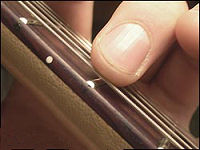5. Harmonic Analysis
Recall the Fourier series (that we met in Full Range Fourier Series):
`f(t)=(a_0)/2sum_(n=1)^ooa_n\ cos nt+sum_(n=1)^oob_n\ sin nt`
`=(a_0)/2+a_1\ cos t` ` +\ a_2\ cos 2t` ` +\ a_3\ cos 3t+... ` ` +\ b_1\ sin t` `+\ b_2\ sin 2t` ` +\ b_3\ sin 3t+...`
We can re-arrange this series and write it as:
`f(t)=(a_0)/2+(a_1\ cos t + b_1\ sin t)` ` + (a_2\ cos 2t + b_2\ sin 2t)` ` + (a_3\ cos 3t+ b_3\ sin 3t)+...`
The term (a1 cos t + b1 sin t) is known as the fundamental.
The term (a2 cos 2t + b2 sin 2t) is called the second harmonic.
The term (a3 cos 3t + b3 sin 3t) is called the third harmonic, etc.
Odd Harmonics
The Fourier series will contain odd harmonics if `f(t + π) = - f(t)`.
Example 1
Graph of `f(t)`, where `f(t + π) = - f(t)`.
In this case, the Fourier expansion will be of the form:
`f(t)=(a_0)/2+(a_1\ cos t + b_1\ sin t)` ` +\ (a_3\ cos 3t + b_3\ sin 3t)` ` +\ (a_5\ cos 5t+ b_5\ sin 5t)+...`
All of the harmonics are odd.
Even Harmonics
The Fourier series will contain even harmonics if `f(t + π) = f(t)`. That is, it has period `pi`.
Graph of `f(t)`, where `f(t + π) = f(t)`.
In this case, the Fourier expansion will be of the form:
`f(t)=(a_0)/2+(a_2\ cos 2t + b_2\ sin 2t)` ` +\ (a_4\ cos 4t + b_4\ sin 4t)` ` +\ (a_6\ cos 6t+ b_6\ sin 6t)+...`
All of the harmonics are even.
Example 2
Determine the existence of odd or even harmonics for the following functions.
(a) `f(t)=` `{ {: (-t-pi/2",", -pi <=t <0),(t-pi/2",", 0 <= t < pi) :}`
`f(t) = f(t + 2π)`.
Answer
Graph of `f(t)`.
We can see from the graph that `f(t + π) = - f(t)`.
For example, we notice that `f(2) = 0.4`, approximately. If we now move `π` units to the right (or about `2 + 3.14 = 5.14`), we see that the function value is
`f(5.14) = -0.4`.
That is, `f(t + π) = - f(t)`.
This same behaviour will occur for any value of `t` that we choose.
So the Fourier Series will have odd harmonics.
This means that in our Fourier expansion we will only see terms like the following:
`f(t)=(a_0)/2+(a_1\ cos t + b_1\ sin t)` ` +\ (a_3\ cos 3t + b_3\ sin 3t)` ` +\ (a_5\ cos 5t+ b_5\ sin 5t)+...`
[Note: Don't be confused with odd functions and odd harmonics. In this example, we have an even function (since it is symmetrical about the y-axis), but because the function has the property that `f(t + π) = - f(t)`, then we know it has odd harmonics only.
The fact that it is an even function does not affect the nature of the harmonics and can be ignored.]
Aside: Music Harmonics
Playing harmonics on a guitar. If you just lightly touch a string with the left hand and then pluck it, you hear a high pitched sound called the harmonic.
Music sounds "in tune" because the harmonics contained in each note sound "right" with certain other notes.
See also Line Spectrum.
(b) `f(t)={ {:(e^(-t),if , 0 {:<=:}t < pi), (e^(-t+pi),if, pi {:<=:} t < 2pi) :}`
Useful Background
Check out Graphs of Exponential Functions.
`f(t) = f(t + π)`.
Answer
Graph of `f(t)`, where `f(t + π) = f(t)`.
As the question states, the function is periodic with period `pi`.
So, we conclude that the Fourier series will have even harmonics, and will be of the form:
`(a_0)/2+(a_2\ cos 2t + b_2\ sin 2t)` ` +\ (a_4\ cos 4t + b_4\ sin 4t)` ` +\ (a_6\ cos 6t+ b_6\ sin 6t)+...`
